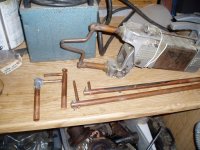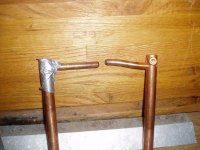Someone mentioned getting a spot welder at HF when I got to the floor pans and rocker panels. I went there and they had a 220 or 120. Is the 220 that much better or will the 120 be enough. Moreover, it looks like I might be able to weld the back and the front of the floors with a spot welder and all alone the inner sill. Is that the case?
-
 Hi Guest!
Hi Guest!
You can help ensure that British Car Forum (BCF) continues to provide a great place to engage in the British car hobby! If you find BCF a beneficial community, please consider supporting our efforts with a subscription.
There are some perks with a member upgrade!**Upgrade Now**
(PS: Subscribers don't see this gawd-aweful banner

Tips
- We have a special forum called "Member Articles" where you can submit actual articles for consideration for publication. Learn More
- Don't have an Avatar? If not, your avatar will default to the 1st character in your username. Go into "Account Details" to change your Avatar.
- Some basic forum navigation info: click
Hey - did you know if you click on the title of a thread it will take you to the first unread post since you last visited that thread?
- Hey Guest - Is your British Car Club in our Clubs database? If not, send me a PM - Basil

- Looking for a local club? Click the "Clubs" tab above and browse hundreds of clubs world-wide.
- Add Android or iPhone APP: click
- Did you know - any picture or video you add in your posts in any marque-specific forum will also get added to the Media Gallery automatically.
- A few more tips about posting and replying: click
- Hey there Guest - be sure to keep your profile page up to date with interesting info about yourself: learn more
- More tips and tricks on Posting and Replying: click
 STOP!! Never post your email address in open forums. Bots can "harvest" your email! If you must share your email use a Private Message or use the
STOP!! Never post your email address in open forums. Bots can "harvest" your email! If you must share your email use a Private Message or use the  smilie in place of the real @
smilie in place of the real @
- Want to mention another member in a post & get their attention? WATCH THIS

- So, you created a "Group" here at BCF and would like to invite other members to join? Watch this!
- Hey Guest - A post a day keeps Basil from visiting you in the small hours and putting a bat up your nightdress!
- Hey Guest - do you know of an upcoming British car event?
 Pretty Please - add it to our Events forum(s) and add to the calendar! >> Here's How <<
Pretty Please - add it to our Events forum(s) and add to the calendar! >> Here's How << 
- Hey Guest - you be stylin'
Change the look and feel of the forum to fit your taste. Check it out
- If you run across an inappropriate post, for example a post that breaks our rules or looks like it might be spam, you can report the post to the moderators: Learn More
- If you would like to try some different "looks" or styles for the site, scroll to the very bottom, on the left and click the Style Selector.
You are using an out of date browser. It may not display this or other websites correctly.
You should upgrade or use an alternative browser.
You should upgrade or use an alternative browser.
TR2/3/3A spot welder at HF
- Thread starter sp53
- Start date
TR3driver
Great Pumpkin - R.I.P
Offline
Hard to say for sure, the HF specs don't quite make sense. But what they say is that the 240 volt model takes over twice as much power as the 120 volt, which presumably mostly goes into the weld; and that the 240 volt can handle up to 3/16" thick while the 120v can only do 1/8". I opted for the 240v, though I had to make up an extension cord to run it from the dryer outlet in the next room.
I've not tried doing floors and rockers; but the short arms and requiring access to both sides of the weld can definitely be hard to work around. I'd be surprised if you don't wind up with places you'd like to spot weld, but cannot with this welder.
Many years ago, a friend of my Dad's (who ran a body shop) was showing off his latest acquisition. This was a spot welder with the tips/electrodes mounted on cables, and he was showing how he could do two welds at once, working from only one side of a panel. Pretty neat! I don't recall now if it plugged into a standard "stick" (SMAW) power supply or had it's own; nor what brand it was. Can't seem to find it on Google, so maybe it wasn't popular, but it sure looked like it would be.
I've not tried doing floors and rockers; but the short arms and requiring access to both sides of the weld can definitely be hard to work around. I'd be surprised if you don't wind up with places you'd like to spot weld, but cannot with this welder.
Many years ago, a friend of my Dad's (who ran a body shop) was showing off his latest acquisition. This was a spot welder with the tips/electrodes mounted on cables, and he was showing how he could do two welds at once, working from only one side of a panel. Pretty neat! I don't recall now if it plugged into a standard "stick" (SMAW) power supply or had it's own; nor what brand it was. Can't seem to find it on Google, so maybe it wasn't popular, but it sure looked like it would be.
Scot1966
Jedi Hopeful
Offline
I would like to have a spot welder. I've looked at Harbor Frieight and Northern, but as Randall said, I don't think those spot welders ( inexpensive ones anyway ) would work where I need to use them. I am holding out for an old used unit with longer electrodes so I can get into difficult places. The fall swap meets are coming up, so I be looking for one. Until then, it's plug the holes with the MIG welder. Back in the 90's my sister, who lives in Sacramento, shipped me her '69 Mustang fastback to "Restore". After seeing the condition of a California car from the 60's, I vowed to never do rust repair again.... I didn't keep the vow.
Rut
Obi Wan
Offline
I've got the HF 220 spot welder and it did a great job on my rockers and portions of my floor pans on my Bugeye. It has limited application due to the short arms, but what it does, it does well. I'm thinking of adding a set of heavy cables to make it more versitile, but don't know if it has enough power to weld with extensions.
Rut
Rut
Offline
Here's my old ARO welder from eBay a few years ago. It's 220 an works great but has a good controller so it works on about everything Ive tried. I made additional electrodes out of 1/4 and 5/8 copper rod. The longer ones are 18 inches. The duct tape helped prevent shorting out on a panel I was welding. I simply cut the rod to length, rounded the 1/4 in rod ends to a rough point, drilled a hole in the 5/8 rods, cut a slit in the ends and another hole for the locking bolt and bolted them together. I didn't bother to make a fine point, like on the HF electrodes, since it works well as is. However, if you wanted to get some tiny spot welds, like some of the originals on my TR3, that would be relatively easy to do. I don't see why you couldn't do the same for the HF welder.





